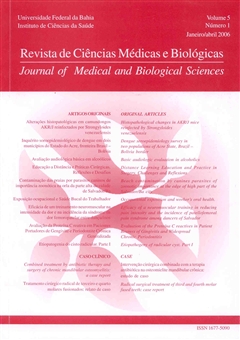Beaches contamination for canines parasites of zoonotic importance at the edge of high part of the Salvador, Ba city
DOI:
https://doi.org/10.9771/cmbio.v5i1.4579Keywords:
Contamination, Beaches-Salvador, Ba. Helminthe, Zoonosis.Abstract
The occurrence of contamination in beaches of Salvador/BA has been evaluated, from Barra to Itapoã, in 786 samples of sand and 266 samples of dog feces, collected during Winter/2004 and Summer/ 2005, In order to identify the presence of canine parasites of zoonotic relevance, that causes both Visceral Larva Migrans (VLM) and Cutaneous Larva Migrans (CLM) syndromes. The samples were submitted to the following techniques: centrifuge-fluctuation, Baermann, spontaneous sedimentation and Willis. In the samples, the sand showed 29.24% of positivity and the canine feces 54.51%. The beaches with higher levels of contamination were: Rio Vermelho, Piatã, Boca do rio, and Itapoã (34 to 37%) in the Winter, and Boca do Rio and Itapoã (39%) in summer. There was not a statistically significant difference between the two periods. The parasites identified were: Ancylostoma sp, Toxocara sp. Toxascaris, Taeniidae, Trichuris and Ascaris, in decreasing order of prevalence. We concluded that the beaches of Salvador have shown constant levels of contamination and this represents an important public health issue, due to the risk of zoonosis transmission.
Downloads
Downloads
Published
How to Cite
Issue
Section
License
The Journal of Medical and Biological Sciences reserves all copyrights of published works, including translations, allowing, however, their subsequent reproduction as transcription, with proper citation of source, through the Creative Commons license. The periodical has free and free access.


